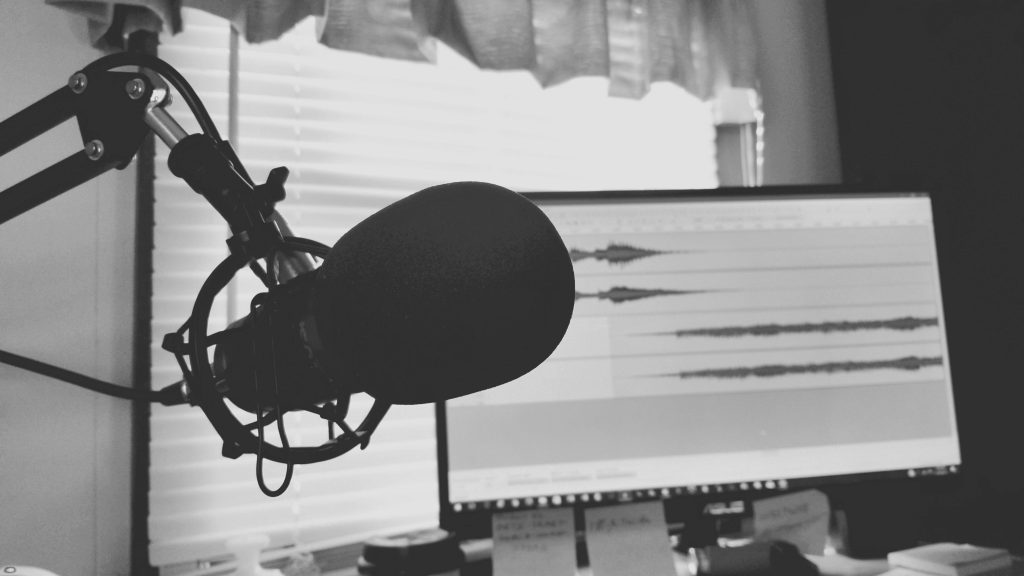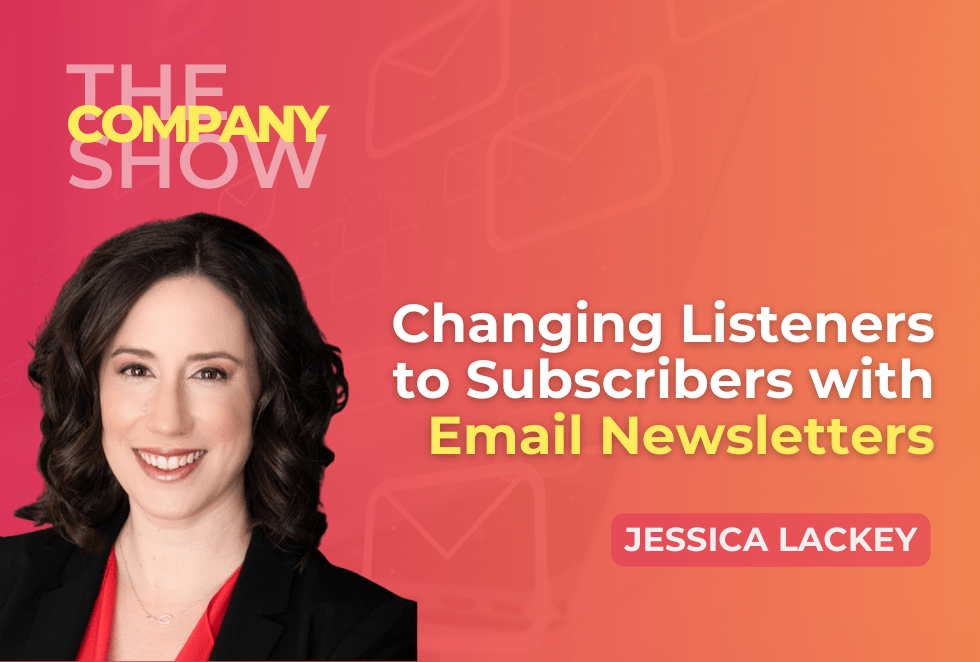You know what podcasts suck at? Conversions.
You know what’s amazing for conversions? Email.
You know how to turn podcast listeners into people that you can email? A newsletter.
A part of podcasting for your business is getting your listeners into a platform where they can click a link to take some action. Sometimes that means doing video. Sometimes it means an active social media presence, and sometimes it means building out your email list, and that’s what we’re talking about today.
Jessica Lackey is a strategy and operations advisor who blends business strategy, practical application, and a human-centric approach to creating sustainable business practices. She’s joining me today to talk about whether or not your show needs a newsletter, what kind of content should go onto it, how to differentiate it from your podcast content, and how to see if it’s all working.
Listen to the episode below or continue reading the blog post!
Tune in to the full episode to learn about:
- Integrating Thought Leadership in Newsletters for Podcast Promotion
- Determining the Role of Newsletters in Your Podcast Strategy
- When Podcasts and Newsletters Aren’t Essential
- The Right Way to Use Episodes in Newsletters
- How to Drive Newsletter Subscribers to Your Show
- Podcast Discovery Challenges and the Power of Cross-Promotion
- Why Human Touch and Curated Content Matter
The Podcasting for Business Conference is happening next week — get your ticket here!
Building Sustainable Foundations for Expertise-Based Businesses

Jessica: “I work with expertise based business owners who primarily grow their business through relationships. And so there’s lots of tactics out there on these internet streets about how to grow your business. A lot of the advice is not designed for us. So I help business owners design, build, and run sustainable businesses through the right business foundations for them.
It’s purpose, people, process tools. So what are the strategies we need to be thinking about as we start our businesses? What are the tools and tech we need? What are the rhythms and rituals by which we need to kind of run our business?
How does our business operate? What are we tracking in our business? It’s all of those things. It’s really the systemic building blocks of the business.”
Rituals in Business
Jessica: “There are things we just do. Maybe you love bookkeeping. I do love my own bookkeeping, but business is sacred and I think there are times where we can just plow through and just kind of be checking the boxes.
But how do we then have designated times in places to really step back, take a big picture about our business, really think through what does my business need as an entity separate than myself, and how do I treat it with the care and compassion? Especially at particular times of the year when we are often most reflective.
A lot of [my clients] are trying to guest on podcasts. I have a lot of people who write newsletters and a lot of people who podcast, but I’m excited to get into the overlap between.
Newsletters and podcasts and what I kind of think we can be doing differently with the combo.”
Going Beyond Guest Spotlights
Jessica: “I’ll talk about the things that I wish people were doing, and I love your report on the different kinds of podcasts in the State of Business Podcasting Report because I really feel like we have to have the right match between our podcast style and our newsletters.
A lot of times people just like podcasters just send the newsletter, announcing that they have a podcast in live. But especially if you run what you call an interview show — usually it’s the guest expert that gets the spotlight. But if you are using this to grow your own authority as a business owner and you just link to the guest being awesome, you’ve missed out on a whole opportunity to demonstrate why you are the expert that curated them.
What’s your point of view? What do you have to say about that? Do you agree and disagree? And I don’t think that’s a bad thing, but you’re seeding your own authority building to the guest expert, which is great for the guest expert, great for exposure, but. How does that serve your, if you’re trying to sell through being an expert by having a podcast and it’s just interview based, what are you selling?”
Megan: “That’s such a good point. And it’s definitely one of my soapbox in the podcasting industry is it’s not thought leadership if all you’re doing is interviewing guests, you can have a thought leadership podcast that has conversation with guests, but as exactly you say, you have to have your own content and your own opinions in there.”
Integrating Thought Leadership in Newsletters for Podcast Promotion
Jessica: “I really think it’s — Why did you bring this person on? What can they learn?
There’s someone, her name is Amanda Navida. I’m gonna sound that totally wrong, but she talks about zero click marketing, which it’s hard to get people from one platform to another. So on social media, they don’t want you to go click the other place. They ding links and things like that. I think newsletter to podcast is a very similar transition.
It can be really hard to just be like, I have this podcast. Go listen to it in my newsletter, but if I’m trying to develop rapport and develop relationships, how can I tease it a little bit? Maybe even give them a nugget. That means they don’t have to go listen to the podcast unless it’s something that’s really catching their eye, but they still learned what your point of view was from the episode, even if they didn’t listen to it.
Because people have more time to read newsletters because they’re shorter than they do podcast slots. And so how can you make your newsletter be both zero click marketing, they get a nugget without having to listen to the podcast. But also you’re enticing them more to listen to the podcast.”
Bridging the Gap Between Podcasts and Newsletters

Jessica: “The biggest challenges, it’s context switching. It’s a lot easier to buy when you’re on your phone looking at a computer. Then when you’re listening to the podcast in the car and they say, buy my thing, and you’re driving, and they can’t click to the sales page.
If you’re trying to sell an offer, put the offer in the newsletter versus just assuming they’ll click into the show notes and buy your thing. So I think it’s, again, how do we demonstrate our own authority, have our own point of view on the guest topic, demonstrate how we connected it to our body of work?
Assume that people might not listen to the podcast episode if they’re busy. And so how can we treat that as if they have time? I’d love for them to listen to it, but even if they don’t, how can I still be in relationship with them and be putting my words out on paper?”
Megan: “Oh, no, I hear what you’re saying. And so I like the idea that we’re talking about here, kind of context switching and the state someone’s in when they’re listening to a podcast. It’s different than when they’re watching a video, when they’re reading a newsletter.”
Determining the Role of Newsletters in Your Podcast Strategy
Jessica: “It depends on the purpose of the podcast. If the purpose of the podcast is to sell your own services of products, for sure you have to have a newsletter because normal human beings, I would say, like in this case, I’m probably abnormal.
I have 10 to 12 podcasts that I listen to a week, I’m listening to three or four day and I have like 20 in my rotation. I subscribe to many, many more newsletters than that. And so again, it takes a lot for someone to earn a podcast listening spot every week, weekend and out.
Yet they can still subscribe to your newsletter. So I think it’s really important to make sure that you have another mechanism, especially if your revenue generation is your own podcast. Now, if the point of the podcast is to get more people to listen to the podcast and you’re not developing your own thought leadership, the goal is to get sponsors, the goal is to grow the audience — I’m not sure you need a newsletter other than announcing it’s here.
I still think it’s important because again, you can talk about it and curate but I don’t know if it’s as required. But if you’re making your money off of selling a product or service, you definitely need to have a newsletter.”
Megan: “Definitely, and I think we’re very much getting into the strategy of the podcast and how that podcast fits into the overall business. Because there are some, say, relationship building podcast, where the real audience of the podcast is the guest rather than anyone who’s listening externally.
Newsletter — not so important. Really nice guest assets — very important. And so making those determinations based on the business goal is ultimately the most important thing.”
When Podcasts and Newsletters Aren’t Essential
Jessica: “One of my favorite episodes [of a show] was By The Book and I don’t know if they had a newsletter — it’s about this concept of jobs to be done. What is the job to be done if I’m simply being entertained by this when it shows up or it’s timely or it’s news-based or something like that where if I miss an episode, I just check in with the next one.
It’s serving a different job for me than more as an education. If I’m just listening to it like Maintenance Phase where I’m not trying to buy from Aubrey and Michael, I’m simply being entertained.
You may not need a newsletter because again, the purpose is different.”
Megan: “Oh, but how glad are you that they’re finally releasing again? It’s been so long. I just listened to the Richard Simmons episode.”
Jessica: “I also listened — well, I tried. I got halfway and I’m like, this is really depressing. I need to come back and listen to it at a different time.
Again, what is the purpose of the business or what is the purpose of the podcast in the business or not in the business. Again, if you’re using it to meet people and get interviews, although I still think that would be important to have a newsletter because if you’re interviewing all these interesting people to build relationships.
Why not tell everyone that is listening to it, what you’re hearing and summarizing it. So I still think it’s important, unless you really don’t want to share, which I get, that would work too.”
The Right Way to Use Episodes in Newsletters

Megan: “One of the things I hear a lot when we’re talking to people and they’re thinking about starting a show or they’ve been podcasting for a while and they want to expand their marketing so they just don’t have any time.
And one of the benefits of podcasting is the efficiency of creating one piece of content that can then become all of the other pieces of content that you shared.
What are, in your opinion, the do’s and don’ts of using your podcast? Your interview, your episode content directly in your newsletter?”
Jessica: “It’s the context, switching the pros and cons. The podcast listener might actually be a different listener than your newsletter listener and vice versa. And so if your podcast is a 45 minute deep dive on some topic and only a portion of your audience is going to listen to it, don’t just make the newsletter just a podcast delivery mechanism.
I think we have to understand who all’s in our audience and not everyone wants a super technical deep dive on something. Some people just want the nuggets. And again, similar goes to podcasts on social. I don’t know if anyone really ever subscribes to listen to a podcast. And you would tell me if I’m wrong, but in the algorithms these days, does anyone really subscribe to, listen to a podcast because of an interesting clip that was shared?
Or does that remind them that this podcast is in their queue? And is it more of a sales tool for people who are already in your world to listen to the podcast that they’re already subscribed to? Or is it really a, oh, someone’s going to see this clip and hear it?
And is it really a sales tools or more of an omnipresent marketing for the people that are already subscribed to the show. It depends on how big you are at LinkedIn and Instagram audiences as well.”
Megan: “I would imagine actually it works the best on YouTube. Podcast shorts on YouTube are really great for getting people to listen to full episodes on YouTube.
They are lousy at getting people to listen to your content anywhere else, so it’s great on platform marketing. The other social media sets lot less conversion because it’s so sticky. Each platform wants you to stay inside itself and they don’t want you to go off and go somewhere else and do something else.”
How to Drive Newsletter Subscribers to Your Show
Megan: “Okay, I’ve got this newsletter. It’s awesome. It’s got all this amazing content in it. Great sales, great offers, great information. Different from the podcast. How do I get my listeners to make that jump?”
Jessica: “I would think it’s actually the opposite way. It’s how do you get your newsletter? It’s much easier to subscribe to newsletter than it is to earn the spot. In the podcast listing rotation, it’s almost the reverse. Are people finding your podcast first? And they need to be convinced to subscribe to your newsletter.
But mostly I see it’s that people subscribe to your newsletter and then make the switch to the podcast.
I have a YouTube channel. It’s very fledgling. I have three times the people on my newsletter than I have on my YouTube subscribers, and I link to my YouTube every time.
So I think I have to make it even more compelling again, like as podcasts can be such an interesting asset that I think you can reference over and over again that it’s not just like the day it came out, but every time you’re talking in your newsletter, talking about a topic — again, if you release weekly, maybe this is less relevant, but every time it’s like a blog post.
Oh, you’re interested in learning more about this other topic. Go listen to the last three podcasts I did. So the podcast gets to be a really long serving asset for you as long as you have like the library of it and link to it and I think callback to your bigger body of work to your most popular episodes.
I think your podcast can be a fantastic way in your email welcome sequence for your newsletter. Why not have — subscribe to the private podcast and get the playlist of my best hits. Why make it an ephemeral asset that goes away versus truly curating playlists if you’re, again on the maintenance phase.
If you love like this type of culture, we have this type of thing. If you are like more like this type of consumer, we have these, these are our best hit episodes. How can we use it as an asset in our business versus a thing that just we pump in week in, week out?”
A Newsletter Strategy for Podcast Growth

Megan: “In the interest of plugging other episodes, if you want to know how a really robust content index can help you do, exactly what Jessica just described, go listen to our episode with Racheal Cook all about content databases.
Of course Racheal and I have very similar concepts. It’s good advice too, because what you’re talking about, this is absolutely rock solid strategy that when you’re a hundred episodes deep, feels really overwhelming to apply. Especially if you didn’t do it from the get go, which is you should always do it from the get go, but if you haven’t, it’s not too late.”
Jessica: “You don’t have to index every one of them, but I think, I don’t know if this is a relevant concept for your people, but I’ve heard it talked about as — there’s the deserts, which are the people that capitalize on interesting opportunities. There’s the grasslands, which are people that talk about the same topic over and over again, which is me. There’s these forests and aquatics.
Russell Hilty came up with this framework. He does the author ecosystem and there’s forest and aquatics where it’s these callbacks. And I think there’s some really interesting things with podcasts where if you have a recurring cast on and you’re like, well, from this podcast, they were on the other three podcasts, and oh, by the way, this is the template or the course that goes along with all that.
I think you can just create, once someone becomes a super fan, and I think they’re a super fan when they listen to your podcast, how can you keep them consuming things in your world and in investing in your world? As well as getting the next listener, but I think it’s much more likely that people are going to find you and then go subscribe to your podcast after they’ve already found you, versus find your podcast and then find you in other places.”
Megan: “That kind of brings us nicely back down to the idea of getting your podcast listeners to subscribe to your newsletter, and it sounds like you’re almost positing that a better podcast growth strategy is to grow your newsletter and use that to feed your podcast rather than vice versa.”
Podcast Discovery Challenges and the Power of Cross-Promotion
Jessica: “Podcasts are so hard on discovery. I’m not saying that it can’t be done. I know podcast discovery is really hard. It’s much, much easier, the barrier to entry, and I’m just quoting people on this topic right now.
There’s someone’s podcast I wanted to recommend, but instead of being a number, there was a comment in the middle of the number, and I actually had to type it a couple times to find it in my Spotify.
And so I had to find the podcast and then I had to be convinced to listen to it by the name and I had to get more than 60 seconds in, but subscribe to my new newsletter? I know I can always unsubscribe and it’s very low risk.
I can’t get back the 60 minutes I spent listening to podcasts, and so it’s much easier in my mind and it lends for a better cross pollination between audiences.
Although if you want to grow your podcast, I think that a great way to grow your podcast is to advertise on other podcasts, because again, you’re catching them in the state. If they’re a podcast listener, they’re more likely going to subscribe to your podcast.”
Megan: “Probably a solid 80% of the podcasts I listened to, I listened to because I heard them.
There was an episode drop on another show that I listened to. I’m looking at you, Vox and Wondery, who are really good with that strategy.”
Jessica Lackey’s Take on The Increase of Podcast Email Opt-Ins
Megan: “You mentioned earlier our research report. We just released the fifth annual State of Business Podcasting Report and there was one data point that I was so excited we discovered so that we could talk about it on this conversation today, and it’s that in compared to last year and previous years, the instance of having an email opt-in on podcast episode pages is way, way up.
It went from under 10 to almost 40% of podcasts that had their episodes on individual pages, which everybody should always do. They had a direct email opt-in on that page. So as someone who focuses on newsletters and on this kind of high level strategic thinking, what do you think is going on here? What’s your take on this data point?”
Jessica: “It’s what we’ve been talking about. I think it’s much easier to make a sale from an email than it is from a podcast. It’s much easier if they’re a casual listener because most listeners don’t power through every episode we put on. It’s much easier to stay in contact with people through a newsletter than necessarily a podcast every week.
I would be interested to see if next year, if this is data available, how many of them are the same Opt-ins. I’ve heard a couple other creators doing is they take their most highly performing podcast or YouTube episodes, have unique email opt-in links so they know who’s coming from a particular episode, or they even change the opt-in, it’s maybe specific to a lead magnet for that particular type of episode So you can really see the true attribution either to a sales page or a product or a newsletter or something like that.
So you know that this particular podcast, you can segment people coming to your list from that topic. So it’s a really interesting strategy if you’ve got the volume to support that.
If you don’t have a lot of downloads, I would definitely not recommend doing that. But if you’re a big creator, are there particular guests that drove more newsletter subscribers? Could be really interesting to see what the drive is directly from podcast links. And it’s linked to subscribe and even sales — Hey, you heard this, you know, podcast coupon code if you listen to this — and really see how much is being driven directly from podcast.
Megan: “It’s amazing strategy as a guest too. We had a guest a little while ago, Nikki Rausch, who has a specific landing page for every podcast that she has a guest on, so she can see exactly how many new visitors came from.
I should do that.”
Jessica: “Part of it is I recognize when people come in. I was on a law podcast and this has a lot but I should actually have a different landing page for everyone. That’s a really great idea.
Megan: “Well, it’s one of those things that — and this is the way it always is with business and marketing, I’m sure you ask this, the stuff that works really, really well is just so much work to set up and to roll out.
There’s ways to make it easier, but it’s a lot.”
Why Human Touch and Curated Content Matter

Jessica: “If you’re saying, I already made the podcast and I made the show notes, and now you’re telling me that I have to put my own spin on it for the newsletter one, I think that’s hard, but two, I think it actually gives you more lifecycle out of that content.
AI might be able to help pull some nuggets out, but I really do think that we value things that seem to take more work. And so if the podcast isn’t just, here’s the link to the podcast, but the newsletter’s like, here’s what I liked and here’s what I was surprised by — it doesn’t have to take that long.
I mean, after a podcast, if you’re a filmer, you could probably record your intro and your outro and you could probably just do another five minutes that you can have your assistant transcribe for you — this is what surprised me and this is what I didn’t expect, and this is how it connects with other pieces of my content.
You just keep talking. You’re already on the mic, so just batch. Do that and then have someone else kind of do the heavy lifting to put it into your email software.”
Megan: “I love that you said we value things that seem to take more work because it reminds me, I was reading about how you’re, when you’re booking flights, they can actually provide you the results of the city to the city on these dates — basically instantly.
But people purchased more when they had that. We’re finding the best results for you, and they make you wait for 30 seconds before you can actually see the results. It’s kind of a similar principle.
I think people not only value something that seems like it takes more work, but there’s the human element of it too. We’re seeing this a lot right now with the rise of AI in podcasting. And if I hear one more Google Notebook LM, two people podcasting about a topic, I don’t know what I’m going to do.
I might become a farmer and start growing potatoes instead of producing podcasts. But there’s something so inhuman about that. And an effort is human. And I think people in business like your customers, that matters to them.”
Short, Valuable Insights for Better Listener Engagement
Jessica: “Going back to the purpose of the podcast — get people to listen to the podcast.
Then do you need a newsletter? Maybe not like it. It might not be for you. I work with authority based business owners. If you’re trying to demonstrate your expertise, make it easy for your audience to hear what you have to say. Sometimes, that making it easy is a voice memo recording of your newsletter.
That could have me the other way around. Like you, if you write your newsletter and then read your newsletter, someone I know does that. Or you have a private PO. You have someone doing six minute voice memo episodes and they’re great and he doesn’t send those out to the newsletters, but he’s building rapport and he’s like, don’t want listen to the hour episode here, listen to my six minute thing.
That has a great retention. But I think in the era of more AI, more noise, more stuff, how do we say, okay, well I didn’t really want to listen to the whole podcast, but there’s a nugget and I’m going to remember that that person took the time to find an interesting nugget, synthesize it, curate it for me, and now I didn’t have to work so hard. I trust them.
It builds trust. And you have this asset. How can you not just splice into clips, but how can you really draw nuggets on it that are gonna help your listener even if they don’t listen to the whole podcast?”
Connect with Jessica Lackey
Jessica: “The people that should find me are expertise-based business owners. Again, you’re selling something, you’re selling your expertise, and you are doing all the thing and really not sure how to make the most of it and grow your business with solid foundations.
You can find me at jessicalackey.com/welcome, where it has the links to my newsletter, YouTube channel.
If you’re interested in working together, I would love to talk.
Final Thoughts
I love Jessica’s focus on the human connection you’re making with listeners.
Having a newsletter is just another way to connect with and engage the actual people listening to your show and that is the foundation for everything else.
Next week is a special one — it’s the Podcasting for Business Conference, and if you don’t have your ticket late in the immortal words of the doors, the time to hesitate is through. (If you can tell me what 90’s movie I’m referencing without googling it, I’ll give you a free ticket, email me at Megan@OneStoneCreative.net)
Check out the lineup and the schedule at PFBCon.com and we’ll see you next week!
Podcasting for Business – The Book
In case you haven’t gotten it yet, my book Podcasting for Business: How to Create a Show That Makes a Bottom Line Difference for Your Company, is available now!
If you think your podcast should be a little bit more profitable (or a lot more profitable), I highly recommend that you check it out.
There’s going to be some great information there for you.
Be A Guest on The Company Show
Do you have a podcast that’s making a major difference in your business or know one that is? Fill out this contact form and let us know about it.
We’d love to have you here for an episode like this one!
Need A Podcast?
As always, this is Megan Dougherty, and The Company Show was made possible by the team at One Stone Creative.
If you know a business owner that you think should have a podcast, do us a favor and send them to podcastingforbusiness.com!
Key Quotes
“If you are using your podcast to grow your authority as a business owner and you just link to the guest being awesome — you’ve missed out on a whole opportunity to demonstrate why you are the expert that curated them.” – Jessica Lackey
Resources
One Stone Creative | LinkedIn | Twitter | Facebook | Instagram
- Order the book, Podcasting for Business
Learn about what other business podcasters are doing:
Jessice Lackey | Website | LinkedIn | Twitter | YouTube

